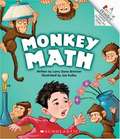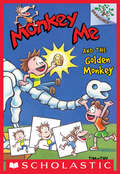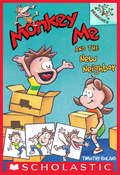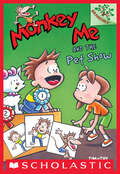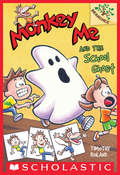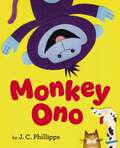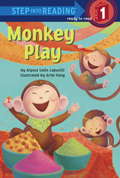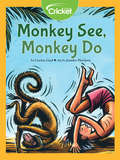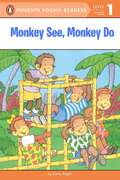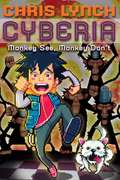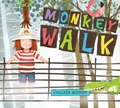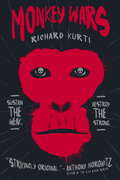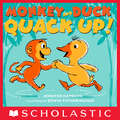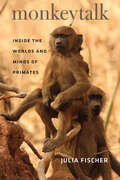- Table View
- List View
Monkey Math
by Larry Dane BrimnerSimple, rhyming text counts monkeys as they swing into a kitchen, enjoy a wild visit, and swing back out.
Monkey Me and the Golden Monkey: A Branches Book (Monkey Me #1)
by Timothy RolandWhen Clyde gets excited, he brings a whole new meaning to "monkeying around!"This series is part of Scholastic's early chapter book line called Branches, which is aimed at newly independent readers. With easy-to-read text, high-interest content, fast-paced plots, and illustrations on every page, these books will boost reading confidence and stamina. Branches books help readers grow!Clyde is an energetic student who just can't sit still. After eating a banana that has been zapped by lasers on his class field trip to the science museum Clyde starts to feel weird. Now every time he gets excited, he transforms into a monkey! Only with the help of his twin sister, Claudia, can Monkey Clyde stay out of trouble.
Monkey Me and the New Neighbor: A Branches Book (Monkey Me #3)
by Timothy RolandWhen Clyde gets excited and hyper, he brings a whole new meaning to "monkeying around!"This series is part of Scholastic's early chapter book line called Branches, which is aimed at newly independent readers. With easy-to-read text, high-interest content, fast-paced plots, and illustrations on every page, these books will boost reading confidence and stamina. Branches books help readers grow!Clyde is an energetic student who just can't sit still. After eating a banana that has been zapped by lasers on his class field trip to the science museum Clyde starts to feel weird. Now every time he gets hyper, he transforms into a monkey! Only with the help of his twin sister, Claudia, can Monkey Clyde stay out of trouble.Whenever Clyde gets excited, he changes from an average elementary school student into a high-energy monkey. This causes Clyde a lot of trouble at school. But what happens when Clyde gets a new neighbor? And that neighbor turns out to be the school principal. Will Clyde be able to stay calm at home?
Monkey Me and the Pet Show: A Branches Book (Monkey Me #2)
by Timothy RolandWhen Clyde gets excited, he brings a whole new meaning to "monkeying around!"This series is part of Scholastic's early chapter book line called Branches, which is aimed at newly independent readers. With easy-to-read text, high-interest content, fast-paced plots, and illustrations on every page, these books will boost reading confidence and stamina. Branches books help readers grow!Clyde is an energetic student who just can't sit still. When he gets too excited, he transforms into a real monkey! When the class bully challenges Clyde's "monkey me" to the pet talent show, he has no choice but to participate. But when the other pets start to disappear, Clyde uses his inner monkey to save the day.
Monkey Me and the School Ghost: A Branches Book (Monkey Me #4)
by Timothy RolandWhen Clyde gets excited and hyper, he brings a whole new meaning to "monkeying around!"This series is part of Scholastic's early chapter book line called Branches, which is aimed at newly independent readers. With easy-to-read text, high-interest content, fast-paced plots, and illustrations on every page, these books will boost reading confidence and stamina. Branches books help readers grow!After eating the banana from a science experiment, Clyde changes from an average elementary school student into a high-energy monkey whenever he gets excited. Usually this causes Clyde a lot of trouble at school. But when someone dressed up like a ghost is seen walking around the hallways, only Clyde's special monkey-powers can save the day!
Monkey Ono
by J. C. PhillippsMonkey Ono is not exactly a real monkey, but he really, really wants to go to the beach! So when Beach Day arrives, and the children who own him forget the bag he's in, Monkey Ono does not take this lying down, like most stuffed animals would. Oh no, he's got a plan. In fact he's got many, many plans. From riding the family dog to ricocheting through the sky to diving down the water pipes. All end with hilarious results, but not exactly according to plan. Will Monkey Ono ever get to the beach?? Only if the beach comes to him...J.C. Phillipps&’s spirited text and stunning illustrations, done in colorful cut paper collage, deliver a humorous story with a great message—try and try again!
Monkey Play (Step into Reading)
by Alyssa Satin CapucilliMonkey Plays is an energetic companion to Bear Hugs and Panda Kisses. One by one, monkeys add to the jungle fun--swinging from palm trees, hiding in an Indian market, and playing from sundown to sun-up!This playful Step 1 features a rhyming text with a bouncy rhythm and bright illustrations.
Monkey See, Monkey Do
by Carolyn GardAzimi and Daud must collect coconuts to sell at market. Can they train their pet monkey to help pick them?
Monkey See, Monkey Do (Penguin Young Readers, Level 1)
by Dana ReganChildren will laugh out loud as they watch the young simian stars of this book swing through one very busy day. From cheering one another on at baseball games, to dancing the conga at a lively party, these monkeys know how to have a great time-all in rhyme!
Monkey See, Monkey Don't (Cyberia #2)
by Chris LynchZane has made an enemy for life in the evil Dr. Gristle, who is jealous of Zane's ability to use technology to talk to animals. He's now working on a new device to control animals' movement and speech--and Zane's dog is one of the first test cases.
Monkey Trouble
by David MartinMONKEY TROUBLE. Pop Pop Pop Pop, Monkey Flies Away, Monkey Eats Worms, Monkey, Watch Out! Monkey is full of surprises--and full of fun! BRAND NEW READERS are perfect for children reading for the very fist time. BRAND NEW READERS promise success with short, funny, easy-to-read stories--and early success helps children become good readers.
Monkey Trouble
by Ellen LeroeTHE COPS, THE CROOKS, AND HER PARENTS ARE ALL OUT TO TAKE EVA’S NEW BEST FRIEND AWAY...BUT THEY’LL HAVE TO CATCH HER FIRST! Nine-year-old Eva Boylan has a problem. Her parents have laid down the law: no pets! But suddenly the solution falls out of the sky--well, out of a tree, anyway--and right into Eva’s arms. It’s a runaway monkey she calls Dodger. The catch is, this particular monkey has a very special talent. Not only has he stolen Eva’s heart, he’s been trained to steal just about everything else. Now con man Shorty Kohn, Dodger’s partner in crime, wants him back and he’s hot on his tail. But a good pet is hard to find and even harder to keep. So Eva’s made up her mind to keep Dodger a secret. After all, what her parents don’t know can’t hurt her. She’s decided to reform her little thief and Shorty the bunglin burgler a real run.
Monkey Walk
by Colleen MaddenIn this near-wordless picture book, a girl’s bad mood is cured at the zoo when she cheers up a group of friendly penguins.How do you shake off a bad mood? Try climbing up the Monkey Walk! On that unpredictable path, you might meet a mischievous (and kind of hairy) stranger. You might go on ridiculous missions. You might even make friends where you least anticipate doing so. It’s a visit to the zoo like no other in Colleen Madden’s zany, wholly delightful tale of a big sister whose sour mood is turned around by helping others in an unforeseen way.
Monkey Wars
by Richard Kurti"Strikingly original" is how Anthony Horowitz, author of the Alex Rider series, describes Monkey Wars. "Kurti draws from history to deliver a powerful allegory . . . [and] keeps this effective, memorable tale rooted in reality." --Publishers Weekly, Starred Review Sustain the weak. Destroy the strong. A dark fable in the vein of Animal Farm, Watership Down, and The Wave, this action-packed page-turner is told entirely from the monkeys' points of view and shines a light on the politics of power, the rise of tyrants, and the personal dilemmas that must be faced when your life is on the line. When rhesus monkeys are brutally massacred on the dusty streets of Kolkata by a troop of power-hungry langur monkeys, Mico, a privileged langur, becomes entangled in the secrets at the heart of his troop's leadership and is shocked at what he discovers. He feels compelled to help the few surviving rhesus, especially Papina, a young female he befriends, even though doing so goes against everything he's been taught. As more blood is spilled, Mico realizes that choosing between right and wrong won't be easy. Includes a note from the author, as well as interesting monkey species facts. Additional praise for MONKEY WARS "The allure of power--even for the most conscientious--is portrayed with frightening effectiveness. Powerful."--Kirkus Reviews "An imaginative fable about the nature of power and the responsibility of the individual. With plenty of action . . . a fascinating epilogue . . . [and] striking cover art." --Booklist "Following in the tradition of George Orwell's Animal Farm and William Golding's Lord of the Flies, war and politics shape the lives of several monkey troops. An interesting premise that will provide readers with an introduction to fascism and political corruption." --School Library JournalFrom the Hardcover edition.
Monkey and Duck Quack Up!
by Jennifer HamburgColorful comedy, rollicking rhyme, charismatic characters, and a funny friendship -- this winning picture book has got it all!Duck and Monkey,best of friends,as different as odds and ends. Monkey's eager, Duck's laid-back.Together do they have the knackto be a winning rhyming teamand satisfy a monkey's dream?Turn the page and try your luck.See if you can out-rhyme Duck!
Monkey's Big Bike (Into Reading, Level D #42)
by Annette Smith Chantal StewartNIMAC-sourced textbook
Monkey's Long Tail (Fountas & Pinnell Classroom)
by Javier Joaquin Valentina ByrneMonkey Wants a Tail Monkey wants a long tail. But he has to do many jobs for others first. NIMAC-sourced textbook
Monkey: A Trickster Tale From India
by Gerald McDermottMonkey is hungry for the delicious mangoes on the island in the river, but he can't swim! How will he get there? Crocodile offers to carry Monkey across the water on his back, so Monkey hops aboard. Trouble is, Crocodile is hungry, too—for Monkey! Will clever Monkey come up with a way to get the mangoes and escape Crocodile's sharp teeth? Master storyteller and artist Gerald McDermott brings the vibrant colors of India to his telling of this classic trickster tale, which has plenty of cleverness and a sprinkling of mischief.
Monkeys (Readers)
by Anne SchreiberThis comical, adorable, and fascinating reader documents the lives of monkeys living in the wild and includes details regarding their behavior, families, and environment. The carefully constructed text guarantees a successful and rewarding reading experience for level 2 readers who are able to read alone, with minor assistance. The photography and extras featured in this title ensure a fun and interactive experience for the reader.National Geographic supports K-12 educators with ELA Common Core Resources.Visit www.natgeoed.org/commoncore for more information.
Monkeys on the Car (Fountas & Pinnell Classroom, Guided Reading)
by Sue Cornelison Sunita ApteNIMAC-sourced textbook. No More Monkeys. Monkeys are cute, but not when they're on the roof of your car How will Malee and her grandparents get the monkeys off the car?
Monkeys on the Edge
by Michael D. Gumert Agustín Fuentes Lisa Jones-EngelLong-tailed macaques (Macaca fascicularis) have a wide geographical distribution and extensively overlap with human societies across southeast Asia, regularly utilizing the edges of secondary forest and inhabiting numerous anthropogenic environments, including temple grounds, cities and farmlands. Yet despite their apparent ubiquity across the region, there are striking gaps in our understanding of long-tailed macaque population ecology. This timely volume, a key resource for primatologists, anthropologists and conservationists, underlines the urgent need for comprehensive population studies on common macaques. Providing the first detailed look at research on this underexplored species, it unveils what is currently known about the population of M. fascicularis, explores the contexts and consequences of human-macaque sympatry and discusses the innovative programs being initiated to resolve human-macaque conflict across Asia. Spread throughout the book are boxed case studies that supplement the chapters and give a valuable insight into specific field studies on wild M. fascicularis populations.
Monkeys on the Edge: Ecology and Management of Long-tailed Macaques and Their Interface with Humans
by Lisa Jones-Engel Michael Gumert Agustin FuentesLong-tailed macaques (Macaca fascicularis) have a wide geographical distribution and extensively overlap with human societies across southeast Asia, regularly utilizing the edges of secondary forest and inhabiting numerous anthropogenic environments, including temple grounds, cities and farmlands. Yet despite their apparent ubiquity across the region, there are striking gaps in our understanding of long-tailed macaque population ecology. This timely volume, a key resource for primatologists, anthropologists and conservationists, underlines the urgent need for comprehensive population studies on common macaques. Providing the first detailed look at research on this underexplored species, it unveils what is currently known about the population of M. fascicularis, explores the contexts and consequences of human-macaque sympatry and discusses the innovative programs being initiated to resolve human-macaque conflict across Asia. Spread throughout the book are boxed case studies that supplement the chapters and give a valuable insight into specific field studies on wild M. fascicularis populations.
Monkeys, Apes, and Humans
by Michael A. Huffman Hiroo Imai Naofumi Nakagawa Masaki Tomonaga Yasuhiro GoThis book introduces to the reader unfamiliar with primatology in Japan three research projects representative of the unique multidisciplinary approach carried out by scientists at Kyoto University, the country's premier institution for primate studies. The projects are all aimed at understanding the age-old questions, where did we come from, and what makes us unique or similar to our primate ancestors? The first chapter, by Naofumi Nakagawa, focuses on the cultural diversity of social behavior in the Japanese macaque. This chapter reviews research on primate culture, in particular the work on Japanese macaques, then presents what is arguably the first example of a culturally transmitted social convention in the species, called "hug-hug". The second chapter, by Michael A. Huffman, introduces our current knowledge of self-medication in primates, based largely on a long-term study of wild chimpanzees at Kyoto University's longest ongoing chimpanzee field in Africa, Mahale, in Tanzania. The suite of behavioral adaptations to parasite infections in chimpanzees is compared with our current knowledge of self-medication in other primates and other animal species. The third chapter, by Yasuhiro Go, Hiroo Imai, and Masaki Tomonaga, describes the ambitious efforts to combine cognitive science and genomics into a new discipline called "comparative cognitive genomics". This chapter provides an overview of recent advancements in chimpanzee comparative cognition, the construction of a chimpanzee genomic database, and comparative genomic studies at the individual level, looking into factors affecting personality and individuality.
Monkeytalk: Inside the Worlds and Minds of Primates
by Frederick B. Henry Jr. Julia FischerMonkey see, monkey do—or does she? Can the behavior of non-human primates—their sociality, their intelligence, their communication—really be chalked up to simple mimicry? Emphatically, absolutely: no. And as famed primatologist Julia Fischer reveals, the human bias inherent in this oft-uttered adage is our loss, for it is only through the study of our primate brethren that we may begin to understand ourselves. An eye-opening blend of storytelling, memoir, and science, Monkeytalk takes us into the field and the world’s primate labs to investigate the intricacies of primate social mores through the lens of communication. After first detailing the social interactions of key species from her fieldwork—from baby-wielding male Barbary macaques, who use infants as social accessories in a variety of interactions, to aggression among the chacma baboons of southern Africa and male-male tolerance among the Guinea baboons of Senegal—Fischer explores the role of social living in the rise of primate intelligence and communication, ultimately asking what the ways in which other primates communicate can teach us about the evolution of human language. Funny and fascinating, Fischer’s tale roams from a dinner in the field shared with lionesses to insights gleaned from Rico, a border collie with an astonishing vocabulary, but its message is clear: it is humans who are the evolutionary mimics. The primate heritage visible in our species is far more striking than the reverse, and it is the monkeys who deserve to be seen. “The social life of macaques and baboons is a magnificent opera,” Fischer writes. “Permit me now to raise the curtain on it.”
Monoclonal Antibody Production
by National Research CouncilInformation on Monoclonal Antibody Production
